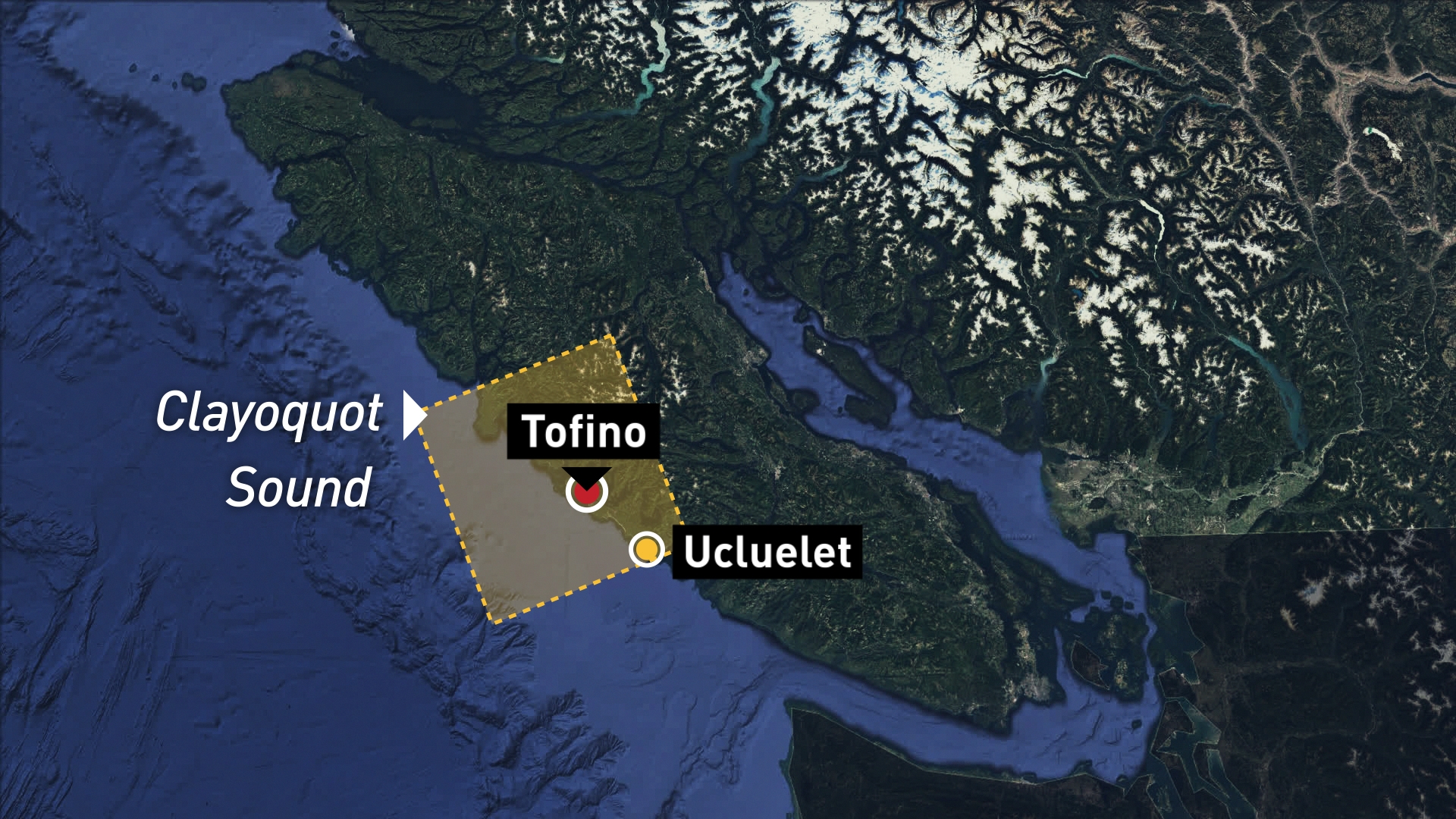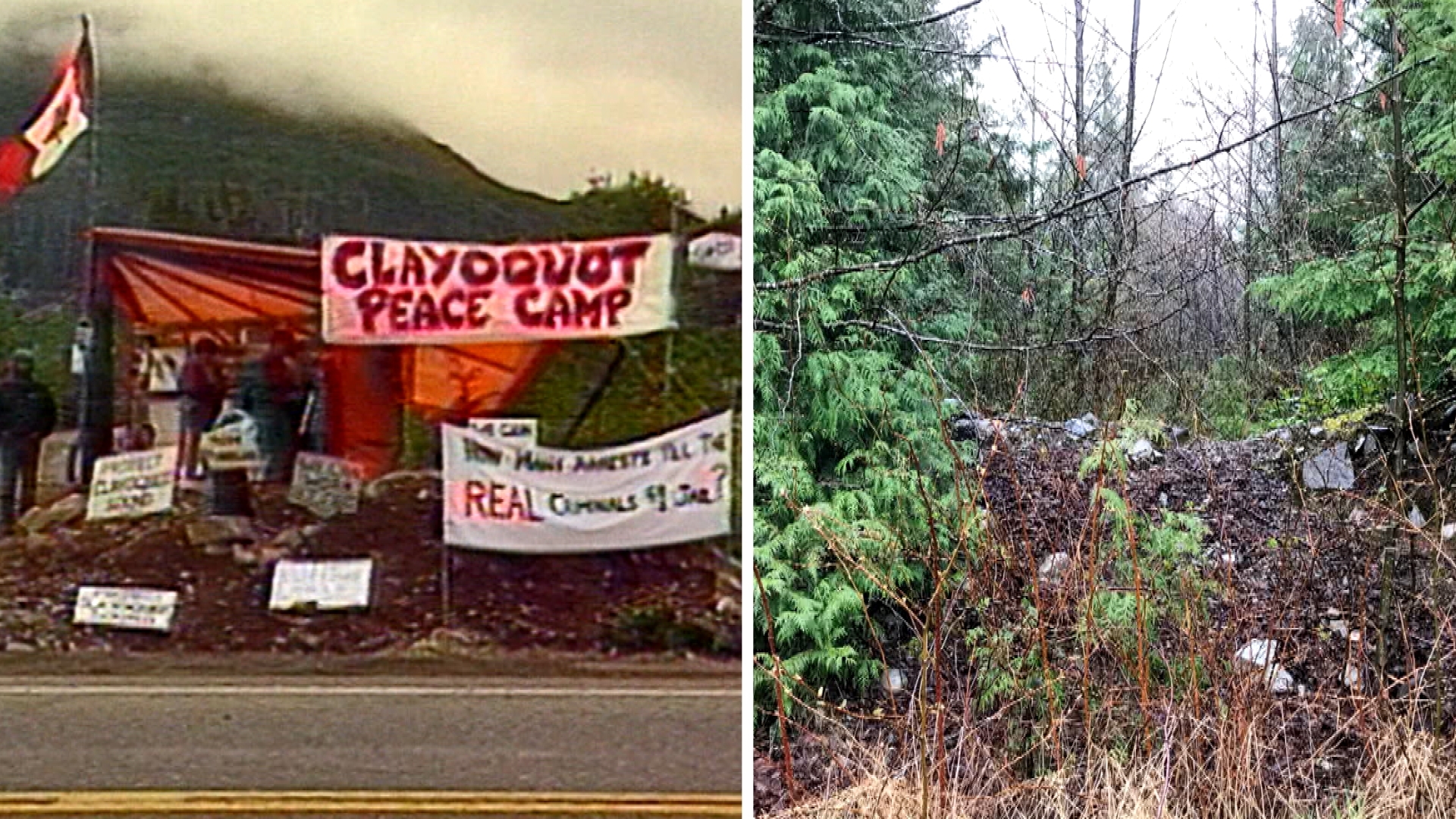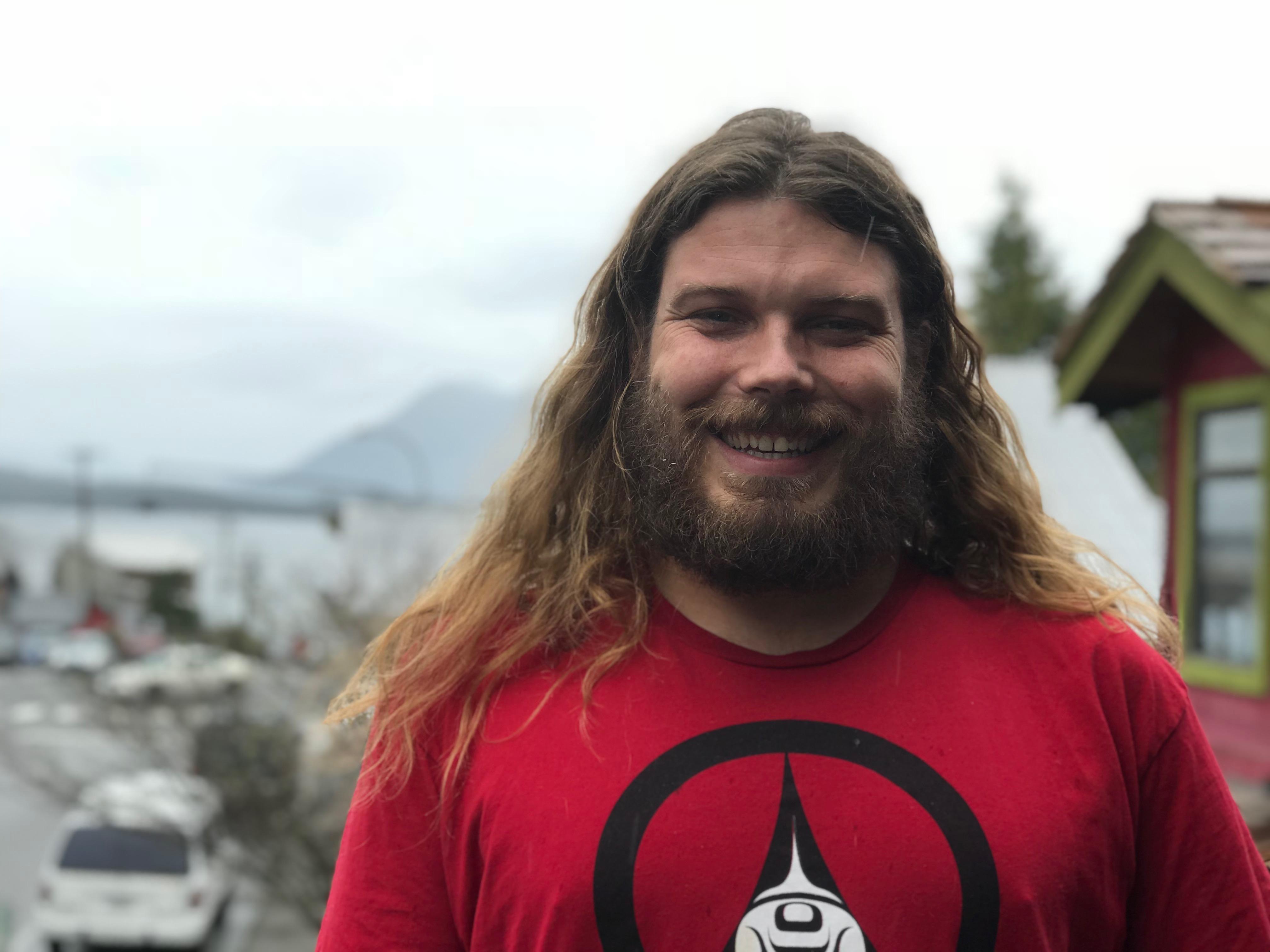April 12, 2018
Swatting at a mosquito, Joe Martin puts down his chainsaw and leans on the end of a red cedar log that's as tall as he is.
This tree, more than 500 years old, was found lying in a creek in the forest along the highway that surrounds the towns of Tofino and Ucluelet, B.C.
Martin is transforming it into a traditional canoe.
"Many tribes on Vancouver Island don't have access to red cedar anymore," Martin says.
"This is my way of helping them so the future generations will have something that they can ride in that their ancestors rode in too."

Martin, a Tla-o-qui-aht carver, doesn't know how this giant old-growth tree wound up in the creek.
But he believes it was spared, in part, by the outcome of a mass protest 25 years ago to save the old-growth forest on Vancouver Island’s west coast.
At its peak in 1993, the War in the Woods drew celebrities and focused international attention on the ancient forests of Clayoquot Sound, 265,000 hectares of old-growth rainforest that surrounds the towns of Tofino and Ucluelet.

It also galvanized B.C.’s environmental movement and inspired a new generation of environmentalists who are now fighting an emotional battle against a pipeline expansion through the province.
Many of the people and groups who put Clayoquot Sound on the map are applying their knowledge and connections to the fight against Kinder Morgan's Trans Mountain pipeline expansion.
Some have called it the next War in the Woods.
'Big moment in Canadian history'
A few more white-knuckled curves up the highway, it's easy to drive right by the swath of bush that became the heart of the famous Clayoquot blockades.
Even 25 years later, Bonny Glambeck honks her horn every time she goes past what became known as the peace camp, located near the turnoff for Tofino and Ucluelet.
"It was a big moment in Canadian history. It's still the largest act of civil disobedience that has happened in Canada."

In 1993, Glambeck was part of a group called Friends of Clayoquot Sound. It formed more than a decade earlier to protect the pristine forests on the west coast of Vancouver Island.
In 1984, the Friends stood with Nuu-Chah-nulth First Nations and stopped a plan for logging on Meares Island.
Other blockades and protests followed. Some people, including Glambeck, were arrested. But standing in front of logging trucks deep in the forest did little to capture media attention.
It was along the highway to Tofino — in a former clearcut dubbed the black hole — that the War in the Woods really gained a foothold.
"It was a very dramatic location for the peace camp because it just so obviously showed what was wrong with the current forest practices," Glambeck says.

Key land use decision
Although tensions over logging in Clayoquot Sound had been simmering for years, the mass protests were sparked by a provincial land use decision in April of 1993.
In an attempt to balance conservation and forestry, the government increased the amount of protected forest, but decided two-thirds of Clayoquot Sound would remain open for industrial logging.
In the months that followed, thousands of people flocked to the area to join the protests.
"There was flags flying from every country representing all the people who had come from all around the world to be here," Glambeck says, standing in front of what used to be the entrance to the peace camp.
The strategy for the mass protest was one of peaceful civil disobedience. The logging trucks were blocked, people were arrested, but eventually the trucks went through.
"That was a point of contention for some of the people involved in the protest. They felt that the goal was to stop the logging. To not symbolically make your statement," she says.
"But I think over time people could see that having that day after day, gaining international media, was worth it."
And gain attention it did.

The Australian rock band Midnight Oil arrived to play a unique concert in the peace camp. Robert Kennedy Jr. made an appearance.
Organizations such as Greenpeace also joined the campaign, shining an international spotlight on the blockades.
Before the summer's end, more than 800 protesters would be arrested and the clash would make headlines around the world.
In this video, Glambeck recalls what it was like to be at the blockades, including the tensions between protesters and loggers.
The blockades themselves were set up at a bridge over the Kennedy River. It was a choke point for logging trucks heading into Clayoquot Sound.
"Essentially you would have the protesters coming out in the morning just at dawn, and there would be probably hundreds of people," Glambeck recalls.
"Many people would be there just to support and witness. They would line the sides of the road, and on any given day there would be a group of people who had chosen to be arrested."
It's a moment Lee McNamee will never forget.

Just nine years old in the summer of 1993, McNamee spent countless days in the peace camp.
In an era before cell phones and social media, his mother's Tofino bakery, The Common Loaf, was a key gathering spot for organizing the mass demonstrations.
One day, McNamee and other children joined the blockade and were removed by police.
"They couldn't arrest me or fingerprint me, which is what they were doing with the rest of the people there, but they could just transport me off of the blockade and wait for my parents to come and pick me up," he says.
"People were waking to the fact that this was everybody's fight."

A different kind of fight was playing out just down the road.
Many families in the town of Ucluelet relied on logging jobs. For them, the summer of 1993 brought turmoil, and then hardship.
"There were so many people at the end of the day that ended up losing their jobs," says Mike Morton, a former logger who was living in Ucluelet with his family.
"Drugs became an issue. Alcohol became an issue for families. There was divorces. This is a story that was never really told about what happened to the community."
At the time, Morton says the logging industry already knew the practices of the 1980s that produced clearcuts such as the black hole had to change.
He hoped the Clayoquot Land Use Decision, signed earlier that spring, would settle the situation down.
"People just wanted to have some stability and normalcy in their lives again. Unfortunately it didn't quite unfold that way."

As the blockades ramped up, so did local tensions.
A yellow ribbon campaign was launched to show support for the loggers. It spread to forestry communities around Vancouver Island.
A group called the Share the Clayoquot Society formed with Morton at the helm.
"It was all about saying look, there is another voice in the wilderness. It's not just about the environmental groups and industry," he says.
"There's a whole lot of other people who are being impacted by these land use decisions."
The tensions also drove a wedge between the communities of Tofino and Ucluelet — something that soon became apparent at the high school the towns share.

David Milligan was the principal at the time.
"I started worrying. I know there are kids on both sides here," he remembers.
Students and teachers were asked to stop wearing anything yellow.
"Don't bring it onto the school. I wanted the school to be a safe place for everybody," Milligan says. "Was that followed 100 per cent? No."
According to Morton, the so-called peaceful protest had a dark side at times. On occasion, logging equipment was damaged.
"There was always a bit of violence. There just was. On both sides," he says. "People were frustrated and fed up."
Morton also recalls people from Ucluelet, along with the logging companies, stepping up to clean up garbage and debris that was left behind when the peace camp ended.

The blockades peaked in August of 1993 when more than 300 people were arrested in the same day.
As the summer drew to a close, so to did the protests. But the point had been made.
Some argue change was underway in the industry before the mass protests, but logging practices did change in the years that followed.
The rate of cut dropped drastically, and forestry policies were also revamped to better manage ecosystems.
Even though the remaining intact valleys of old-growth in Clayoquot Sound did not receive legal protection, they haven't been logged since.
Some smaller scale logging has continued through a company owned by First Nations.
The region has also been declared a UNESCO biosphere reserve to recognize that it is a globally significant ecosystem.

On the edge of Tofino, Friends of Clayoquot Sound still have an office.
Jeh Custerra — a kid growing up on the prairies during the upheaval of the 1990s — is now a campaigner for the organization.
It still works to protect the forest, but fish farms and the potential of mining in Clayoquot Sound are also on the radar.
So too is the new battle on the the B.C. coast — the Trans Mountain pipeline expansion.
The Friends of Clayoquot Sound have been providing training for people wanting to take a stand against the controversial project.
Some who stood in front of logging trucks in Clayoquot Sound, have also joined demonstrations and rallies against the pipeline.

Christine Lowther of Tofino is among them. She was arrested at a 1992 logging blockade and continued to support the Friends of Clayoquot Sound through the hectic summer the next year.
"It was so many people giving a damn," she says of the protests that became a watershed moment for the environmental movement.
The War in the Woods also signalled the start of a better understanding of Indigenous rights and territory, Lowther says. It's another reason she supports the current fight against the pipeline.
"It's time for us to give back. We did then, and we are again now."
Glambeck has also been supporting the pipeline resistance through a new organization she formed with her partner, called Clayoquot Action. The two became a couple 25 years ago in the peace camp.
"The peace camp was a bit like Woodstock in a way. The summer of love," she says.

Across the Georgia Straight, in the Vancouver suburb of Burnaby, about 200 hundred people have been arrested so far protesting the pipeline expansion.
But there are differences between the two protests.
For one, the pipeline protests are led by First Nations. Demonstrators at Burnaby Mountain are also taking on the larger international issue of climate change and carbon emissions.
For Morton, the argument against expanding the pipeline is not as tidy as the pitch environmentalists had to save beautiful trees in Clayoquot Sound.
"We have to get our products to international markets. It's a lot safer in a pipeline than it is on trains, and it is going to get to the coast somehow," he says of the diluted bitumen that would flow through the expanded pipeline from Alberta.
"We have to move away from fossil fuels, but until we're at that point where we are capable of doing it, I think we have to continue to recognize that there's thousands and thousands of Canadians that rely upon our resource industries."
But the tactics and the passion on Burnaby Mountain harken back to the summer of 1993 in Clayoquot Sound. Custerra says that's not a coincidence.
"When I'm out in the ocean having a surf and I'm looking back toward the mountains and I think, wow, people fought for this place," Custerra says.
"They were so in love with it. They wanted to protect it. That's beautiful."

Back at the creek beside the highway to Tofino, Joe Martin will spend the next several weeks carving this fallen old-growth red cedar.
"It's a log that was standing for over 500 years as a tree," he says.
By the time he's done, the new battle on the B.C. coast may well be over.
Kinder Morgan has put the brakes on further spending on the federally approved pipeline expansion — saying opposition in B.C. is causing too much uncertainty.
The Texas-based company has set a deadline for the end of May to find what it calls "a path forward."
Protesters are claiming it as a victory. But others say it only serves to put pressure on the federal government to to quell the resistance in B.C.
The story of the pipeline has yet to be fully written.
But 25 years on, Martin says the War in the Woods has stood the test of time.
Cars carrying tourists stream past on the highway to Tofino and Ucluelet — rather than logging trucks.
"All these mountains would be bare by now if we didn't stop it," he says, getting back to work carving a canoe from a tree that may well have been spared by the battle for Clayoquot Sound.

